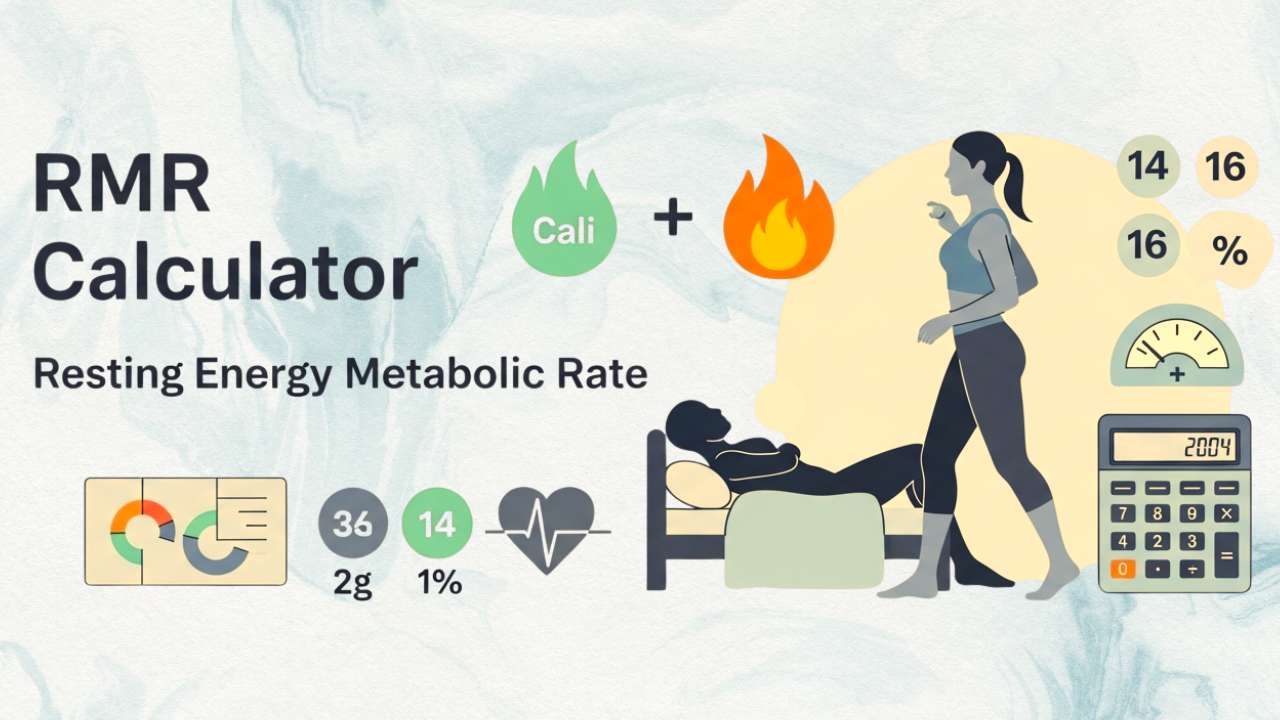RMR Calculator – Resting Metabolic Rate
Calculate your Resting Metabolic Rate (RMR) and Total Daily Energy Expenditure (TDEE) using multiple scientifically validated equations

What is Resting Metabolic Rate (RMR)
Resting Metabolic Rate (RMR) is the number of calories your body burns while at complete rest to maintain vital physiological functions. Recent research indicates that RMR typically accounts for 60-75% of total daily energy expenditure in sedentary individuals and represents the largest component of metabolism. Unlike Basal Metabolic Rate (BMR), which requires strict measurement conditions, RMR is measured under less restrictive circumstances and is more practical for clinical and fitness applications.
RMR vs BMR: Key Differences
While often used interchangeably, RMR and BMR have distinct measurement protocols. BMR requires 8+ hours of sleep, 12-hour fasting, and measurement in a darkened room under strict conditions. RMR measurements are less restrictive, requiring only overnight fasting and rest, making them more practical for everyday use. Clinical studies show RMR is typically 10-15% higher than BMR due to the thermic effect of food and less stringent measurement conditions.
Factors Affecting RMR
Multiple factors influence your RMR including age (decreases ~2% per decade after 20), gender (males typically 10-15% higher), body composition (muscle tissue burns 3x more calories than fat), genetics, hormones, and environmental factors. Recent research demonstrates that lean body mass is the strongest predictor of RMR, making body composition assessment crucial for accurate metabolic calculations.
Clinical Importance
Accurate RMR assessment is fundamental for weight management, athletic performance, and clinical nutrition therapy. Healthcare professionals use RMR calculations for determining caloric needs in patients with metabolic disorders, designing weight loss programs, and optimizing athletic nutrition plans. Understanding your RMR helps establish appropriate caloric intake for maintaining, losing, or gaining weight effectively and safely.
RMR Prediction Equations – Scientific Comparison
Equation Accuracy & Validation Studies
| Equation | Population | Accuracy | Best Use Case | Limitations |
|---|---|---|---|---|
| Mifflin-St Jeor | General population (n=498) | ±10% (82% accurate) | Most individuals, clinical settings | Less accurate for very muscular individuals |
| Harris-Benedict | Healthy adults (1919 study) | ±15% (70% accurate) | Historical reference | Overestimates in modern populations |
| Katch-McArdle | Athletic populations | ±5-8% (athletes) | Known body composition | Requires accurate body fat measurement |
| Cunningham | Very lean individuals | ±3-5% (lean athletes) | Contest prep, elite athletes | Overestimates in higher body fat |
| Owen | Hospitalized patients | ±12-15% | Quick estimates, clinical | Weight-only, less precise |
Accuracy Note: Systematic reviews show that no single equation is perfect for all populations. The Mifflin-St Jeor equation performs best across diverse groups, while lean body mass equations excel for athletic populations with known body composition.
Clinical Applications & Professional Use
Weight Management Programs
RMR calculations form the foundation of successful weight management by establishing baseline caloric needs. Clinical studies demonstrate that individuals who understand their RMR achieve better long-term weight management outcomes. Healthcare providers use RMR to create personalized caloric deficits for weight loss (typically 500-1000 calories below TDEE) or surpluses for healthy weight gain, ensuring sustainable and medically appropriate interventions.
Athletic Performance Optimization
Sports nutritionists rely on accurate RMR assessments to fuel athletic performance and recovery. Research in athletic populations shows that underfueling (eating below RMR) can lead to decreased performance, increased injury risk, and metabolic suppression. Elite athletes often require 2-3x their RMR in total daily calories, making accurate baseline measurements crucial for optimal training adaptations and competitive performance.
Medical Nutrition Therapy
Healthcare professionals use RMR calculations for patients with metabolic disorders, diabetes, cardiovascular disease, and during recovery from illness. Accurate energy requirement assessment helps prevent malnutrition, supports healing, and optimizes therapeutic outcomes. RMR measurements are particularly important for elderly patients, where metabolic changes and medication effects can significantly impact energy needs and nutritional status.
Metabolic Health Assessment
Changes in RMR can indicate metabolic health status and adaptation to diet or exercise interventions. Emerging research suggests that RMR monitoring can help identify metabolic adaptation, thyroid dysfunction, and the effectiveness of lifestyle interventions. Regular RMR assessment provides valuable insights into metabolic flexibility and overall health status.
Factors Influencing RMR – Controllable vs Uncontrollable
Uncontrollable Factors
- Age: RMR decreases ~2% per decade after age 20 due to muscle mass loss and hormonal changes
- Gender: Males typically have 10-15% higher RMR due to greater muscle mass and testosterone
- Genetics: FTO gene variants can affect RMR by up to 160 calories/day
- Height: Taller individuals have higher RMR due to greater surface area and organ mass
- Ethnicity: Some populations show systematic differences in metabolic rate
Controllable Factors
- Muscle Mass: Each pound of muscle burns ~6-10 calories/day at rest
- Physical Activity: Regular exercise increases RMR for hours post-workout
- Sleep Quality: Poor sleep can reduce RMR by 5-20%
- Nutrition: Adequate protein intake supports muscle maintenance and thermic effect
- Hydration: Dehydration can decrease RMR by 2-3%
- Stress Management: Chronic stress elevates cortisol, affecting metabolic rate
How to Optimize Your RMR
🏋️ Build and Maintain Muscle Mass
Resistance Training: Engage in strength training 2-3 times per week to build and maintain muscle mass.
Even a 2-4 pound increase in muscle can boost RMR by 90-110 calories daily. Focus on compound movements like squats,
deadlifts, and pull-ups that engage multiple muscle groups.
Protein Intake: Consume 0.8-1.2g protein per kg body weight (higher for athletes) to support muscle
protein synthesis. Protein has the highest thermic effect of food, temporarily increasing RMR by 15-30% for 3-5 hours.
😴 Prioritize Sleep Quality
Sleep Duration: Aim for 7-9 hours of quality sleep nightly. Sleep deprivation can reduce RMR by 5-20%
and disrupt hormones regulating hunger and metabolism (leptin, ghrelin, cortisol).
Sleep Hygiene: Maintain consistent sleep schedules, cool room temperature (65-68°F), and limit screen
exposure before bed. Poor sleep quality can lead to metabolic dysfunction and reduced energy expenditure.
🔥 Incorporate Thermogenic Activities
HIIT Training: High-intensity interval training can elevate RMR for 12-24 hours post-exercise through
excess post-exercise oxygen consumption (EPOC). Include 1-2 HIIT sessions weekly.
Cold Exposure: Cold showers, ice baths, or cool environments can temporarily boost RMR by 10-15% as
your body works to maintain core temperature. Brown adipose tissue activation increases calorie burning.
⚠️ Avoid Metabolic Damage
Avoid Extreme Caloric Restriction: Eating significantly below RMR (>25% deficit) can suppress metabolism
by 10-40%. Maintain moderate deficits (15-25%) for sustainable weight loss without metabolic adaptation.
Diet Breaks: Incorporate periodic diet breaks (eating at maintenance) every 6-12 weeks during weight loss
to help restore metabolic rate and hormone levels. This prevents long-term metabolic suppression.
Latest Research & Scientific Validation
Metabolic Rate Variability in Modern Populations
“Resting Metabolic Rate of Individuals” (2023)
PMC Research Study –
This comprehensive review examines individual variability in RMR and factors affecting accuracy of predictive equations.
The study emphasizes that while equations provide good population estimates, individual variation can be significant,
highlighting the importance of personalized metabolic assessment in clinical practice.
RMR Prediction Accuracy in Athletes
“Accuracy of Resting Metabolic Rate Prediction Equations in Athletes” (2023)
Systematic Review & Meta-Analysis –
This landmark study analyzed 29 studies with 1,430 athletes, comparing 100 different RMR equations. Results show that
athlete-specific equations perform better than general population formulas, with the Ten-Haaf equation showing superior
accuracy (80.2% within ±10%) for athletic populations.
Clinical Applications and Precision Medicine
“Precision Nutrition and Metabolic Assessment” (2024)
Nature Scientific Reports –
Emerging research in precision nutrition emphasizes the importance of individual metabolic profiling. This study
demonstrates how combining RMR measurements with genetic markers, body composition, and lifestyle factors can
significantly improve the accuracy of energy requirement predictions for personalized nutrition interventions.
Technology Integration and Future Directions
“Wearable Technology and Metabolic Monitoring” (2024)
Journal of Clinical Medicine –
Recent advances in wearable technology are revolutionizing RMR assessment. This research explores how continuous
monitoring devices, combined with machine learning algorithms, can provide real-time metabolic insights and improve
the accuracy of energy expenditure predictions in free-living conditions.
Limitations & Important Considerations
While RMR calculations provide valuable insights into metabolic health and energy requirements, several important limitations should be considered for optimal application:
- Individual Variation: Predictive equations provide population averages; individual RMR can vary by ±20% due to genetics, hormones, and metabolic efficiency. Direct measurement via indirect calorimetry remains the gold standard.
- Body Composition Dependency: Standard equations don’t account for muscle-to-fat ratio differences. Individuals with higher muscle mass may have significantly higher RMR than predicted by weight-based equations.
- Medical Conditions: Thyroid disorders, diabetes, PCOS, and medications can significantly alter RMR independent of age, gender, and weight. Medical supervision is recommended for individuals with metabolic conditions.
- Metabolic Adaptation: Prolonged caloric restriction can suppress RMR by 10-40%, making weight loss plateaus common. Equations don’t account for this adaptive thermogenesis.
- Environmental Factors: Temperature extremes, altitude, stress, and sleep quality can temporarily affect RMR by 5-15%, which standard equations cannot predict.
- Measurement Timing: RMR varies throughout the day and menstrual cycle. For consistency, measurements should be taken under standardized conditions (morning, fasted, rested).
- Population Specificity: Equations developed on specific populations may not apply equally to all ethnic groups, ages, or body compositions. Consider population-specific equations when available.
Clinical Recommendation: Use RMR calculations as a starting point for nutritional planning, then monitor actual outcomes (weight changes, energy levels, performance) to adjust recommendations. For precise metabolic assessment, consider professional indirect calorimetry testing.
⚕️ Medical Disclaimer
This RMR calculator provides estimates based on scientifically validated equations and should not replace professional medical advice. Individual metabolic rates can vary significantly due to genetics, medical conditions, medications, and other factors. The calculations provided are for educational purposes and general guidance only. Consult with healthcare professionals, registered dietitians, or certified nutritionists before making significant dietary changes, especially if you have pre-existing health conditions, are pregnant, breastfeeding, or taking medications that may affect metabolism.
Related
- Mifflin-St Jeor: Equation & Calculator
- Weight Loss Calculator: Free Deficit Calorie Calculator
- Total Daily Energy Expenditure (TDEE) Calculator
- Crunches Calories Burned Calculator
- Sit-Up Calories Burned
- Zumba Calories Burned Calculator
- Pull Up Calories Burned Calculator
- Push-Up Calories Burned Calculator
- Home Activities Calories Burned Calculator
- Exercise Calories Burned Calculator
- Running Calorie Calculator
- Walking Calorie Burned Calculator
References
- Plaza-Florido A, Alcantara JMA. Resting Metabolic Rate of Individuals. Metabolites. 2023 Aug 8;13(8):926. doi: 10.3390/metabo13080926. PMID: 37623870; PMCID: PMC10456516.
- McMurray RG, Soares J, Caspersen CJ, McCurdy T. Examining variations of resting metabolic rate of adults: a public health perspective. Med Sci Sports Exerc. 2014 Jul;46(7):1352-8. doi: 10.1249/MSS.0000000000000232. PMID: 24300125; PMCID: PMC4535334.
- Gitsi, E.; Kokkinos, A.; Konstantinidou, S.K.; Livadas, S.; Argyrakopoulou, G. The Relationship between Resting Metabolic Rate and Body Composition in People Living with Overweight and Obesity. J. Clin. Med. 2024, 13, 5862.
- Maciejczyk, M., Bawelski, M., Wiecek, M., Palka, T., Bujas, P., Piotrowska, A., & Szygula, Z. (2023). Resting metabolic rate is increased after a series of whole body vibration in young men. Scientific Reports, 13(1), 1-6. https://doi.org/10.1038/s41598-023-44543-3
- Maciejczyk, M., Bawelski, M., Wiecek, M., Palka, T., Bujas, P., Piotrowska, A., & Szygula, Z. (2023). Resting metabolic rate is increased after a series of whole body vibration in young men. Scientific Reports, 13(1), 1-6.
- Verma, N., Kumar, S.S. & Suresh, A. An evaluation of basal metabolic rate among healthy individuals — a cross-sectional study. Bull Fac Phys Ther 28, 26 (2023). https://doi.org/10.1186/s43161-023-00139-6

Manish is a NASM-certified fitness and nutrition coach with over 10 years of experience in weight lifting and fat loss fitness coaching. He specializes in gym-based training and has a lot of knowledge about exercise, lifting technique, biomechanics, and more.
Through “Fit Life Regime,” he generously shares the insights he’s gained over a decade in the field. His goal is to equip others with the knowledge to start their own fitness journey.
